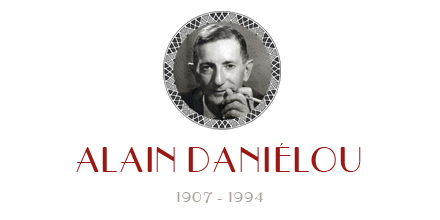EDITO
Alain Daniélou is a annoying, troublesome and disturbing character, an agitator with ideas contrary to politically correct and prevailing ideologies.
From a western point of view, he has no university background, he never claims to be a scientist, studying India and the Hindus as an entomologist studies ants. He describes himself as an artist, a lover of beauty, a free soul, and the multitude of his interests make him unclassable, whimsical, unpredictable.
He is also a formidable expert on the innermost, traditional India, which he experienced from inside, even considering it as his own country, his fatherland. In his Indian studies, he is inescapable, and even his detractors are sometimes obliged to use his terminology. His book on Hindu religion – The Myths and Gods of India, originally published in 1960 – is still the reference book on the subject. His international status is evident, considering that his works are published in 12 languages, in more than 17 countries. In the chilly monotheistic Western world, propped up by its democratic ideology, and terribly ignorant of traditional Indian society, the sole fact of using the words ‘caste’ and ‘polytheism’ in a positive manner has brought down on him the anathemas of those who, as often as not, have never set foot in India, nor read a single line of his works.
So far, in India, his books are only available in English, and thus to a caste of westernised Indians who usually read nothing in the languages of their own country and have adopted a puritanism inherited from the Victorian era of triumphant British colonialism. They too are thus greatly opposed to a thinker who supports orthodox society, with which they are not familiar and which they wish to eliminate, who was one of the first to take an interest in erotic temple sculptures, and – the height of provocation – flaunts his perfectly adjusted homosexuality.
Consequently, opposition to Daniélou is fiercely anchored in various circles. At the same time, I should state that I am far from thinking that his many-sided work deserves only praise and compliments. But, as always, criticism is only acceptable with reference to a given text, and requires a certain familiarity with his works.
As his collaborator for 32 years, and having had the good fortune to learn from him that “art of living” that is so different to Western practice, my aim has been to propagate his work and make available to readers everything he wrote during his long life. I have now reached the end of this task, which will henceforth give all the chance to judge, but will, above all, provide the West with access to a form of society, a religion and philosophy of life that may open new horizons to our societal systems. This does not mean transposing as such principles belonging to a society that has not experienced our history and development. But such an ancient and vast culture, the highest forms of
philosophical thought, backed up by an immense literature, that laboratory which is India, for centuries the home of a multi-cultural, multi-religious, multi-ethnic and multi-lingual society, cannot continue to be ignored, since it may provide the key to the same problems that our western world has been tackling over the past decades.
Daniélou’s work is, in this sense, of prime importance.
On the musical and musicological level, there is a wide consensus acknowledging Daniélou’s great merit as one of the first and the mainspring in introducing to the West the music of the world, and for having helped preserve, propagate and support the music of Asia’s highest cultures. His work at Unesco, the Institutes he founded in Venice and Berlin, bear witness to his work and decisive action in this field.
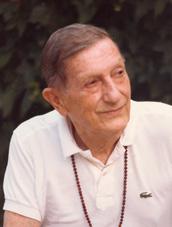 Alain Daniélou’s character was certainly highly complex, with two a prior contradictory tendencies. Whereas on the one hand he may have been found worldly, launched in cultivated international society, concerned about his knitted tartan ties, driving a Jaguar or a Porsche, very flattered by the decorations and acknowledgements bestowed on him, on
Alain Daniélou’s character was certainly highly complex, with two a prior contradictory tendencies. Whereas on the one hand he may have been found worldly, launched in cultivated international society, concerned about his knitted tartan ties, driving a Jaguar or a Porsche, very flattered by the decorations and acknowledgements bestowed on him, on
the other he was far from being civilized, he drove at high speed in his sports cars, wore his tartan ties solely on white short-sleeved Lacoste shirts, which he washed himself every weekend, even when he was earning a very comfortable salary as director of the Berlin and Venice Institutes.
I feel that this dualism precisely matches his personal position: his European origins and his family circle correspond to the first aspect, while his integration with traditional Hindu society throws light on the second.
Concerned above all with knowledge, rejecting ideology, sectarianism, and dogmatism, he learned from the Hindus to call things continually to question and never to limit himself to ‘established’ facts. This is not all: like the Saddhus, the wandering mendicant monks found throughout India, he considered that one’s behaviour should ensure one’s rejection by the bourgeois establishment, thus giving one the greatest possible freedom of thought. This also matched his opposition to private property, his nomadic side, ready at any moment to leave a place or country and to live other lives, his aptitude for work, wherever he might be. His ‘outing’ in 1981, when he openly declared his homosexuality, was part of the same technique, as also his way of shocking or even scandalising people by frequent statements wholly contrary to what might be deemed ‘politically correct.
Jacques Cloarec, 2008.
MUSIC
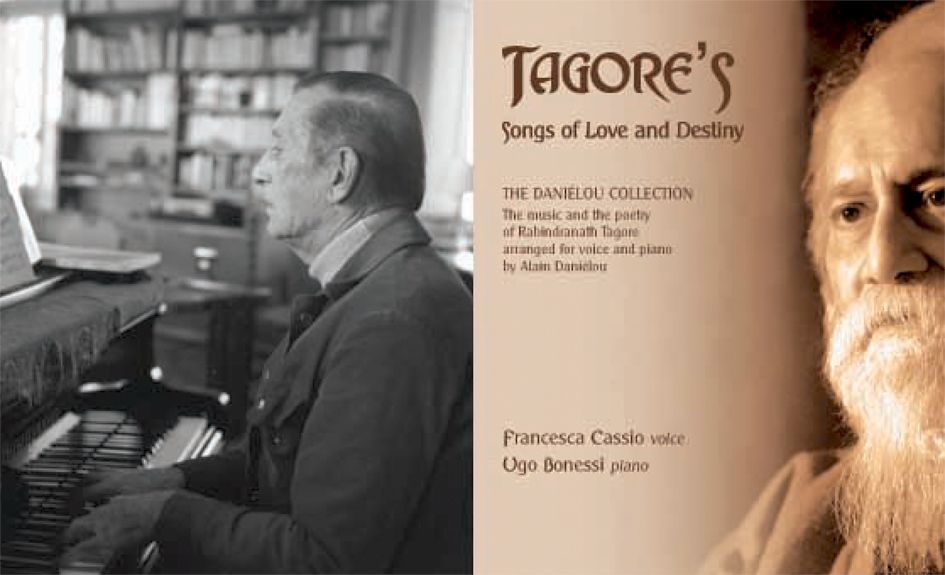
Tagore’s Songs of Love and Destiny
Translated and specially transcribed for voice and piano by Alain Danielou (1907 – 1986) Presented by Francesca Cassio (vocalist) and Maestro Ugo Bonessi (piano)
Introduction and presentation of Tagore’s songs in Bengali by Dr. Reba Som Collaboration: Italian Embassy Cultural Institute; Alain Danielou Center; and Delhi Music Society,
Rabindranath Tagore Centre, ICCR, Kolkata
“Songs and Poetries of Rabindranath Tagore in the Transcription of Prof. Alain Danielou for Voice and Piano”
Performed by Francesca Cassio and Ugo Bonessi
As Professor Alain Danielou writes in his biography, Tagore requested him to transcribe some songs from the Rabindra Sangeet according to the western vogue of the time, for voice and piano. It was infact The Poet’s wish that some of his songs could be sung also in the West. It was an innovative concept that Tagore himself wanted to promote, and that up nowdays nobody has yet performed in this form. Alain Danielou worked over 50 years on this project. He translated into english and transcribed for piano only 18 songs, in a way that the original melodies -with their embellishments and peculiar raga movements- could be recognized, but with a piano harmonic accompaniment that could support and emphasize the meaning of the poetries. The work of Danielou shines mostly in the elegant piano arrangement, and in the beautiful translation into english (and french) that match with the melodies as well as with the meaning. The blending of the musical Indian language with the western notation, and harmony, requires skills in both discipline, and for this reason for long time these song have never been performed. Due a professional training in both Classical Western and Hindusthani vocal music, in 2007 Dr. Francesca Casio and
Maestro Ago Bonessi have been in charge on the behalf of the Danielou Foundation to perform and record -for the first time- the cycle of the 18 songs of Tagore transcribed by Alain Danielou.
The concert will be introduced by the rendition of some songs in the original bengoli version performed by Dr. Mrs. Reba Som, one of the leading scholar and performer of Rabindra Sangeet.
Dr. Mrs. Francesca Cassio is an Italian singer, and phd scholar, trained in Indian vocal music.
Lecturer of Indian Music at the Conservatory of Vicenza and Lecturer of Ethnomusicology at the University ofTrento (Italy).
Started her studies in Indian Music in 1991 at the Fondazione Cini, Venice with Sangeeta Chaterjee. Trained since 1994 in the tradition of dhrupad singing by Padmabhushan Ustad Rahim FahimuddinDagar, and Amelia Cuni. She studies since few years the romantic genre of thumri under the precious guide of Padmabhushan Smt. Girija Devi, and Saira Begum.
Ph.D. in Ethnomusicology (in affiliation with BHU, under the guide of Prof. Ritwik Sanyal), with a fieldwork-research on last living courtesans of India (baiji-s), she had the chance to learn from them their rare musical and danced repertoires. Dr. Cassio regularly performs and records for Italian national television, theatres, radio and cinema. Her music and performances are realised on cads by Warner bros., and other international companies. Composer of music and lyrics, she won national awards in this
field. Among her collaborations, the Oscar Awardees Luis Bacolod and Nicola Giovanni, the winners of Mercury Prize Talvin Sing and Robert Miles, the international best seller Taffetas, Eddi Powell, Paolo Vivaldi, Susanna Tamaro, Roberto Laneri. Author of the book: “Percorsi della Voce”, Ut Orpheus Ed, 2000, Bologna: and writer of several articles on international journals.
Maestro Ugo Bonessi:
Ugo Bonessi was born in Rome in 1961. He took his degree in piano with Maestro Fausto Di Cesare. He has been present on the Rome music scene for many years, not only on the concert stage, where he has performed as a soloist, in duo piano performances, with orchestra, and in duos for piano and voice, but also as a musicologist, teacher, and organizer of concerts. He has organized and performed in several festivals of Russian music sponsored by the Soviet Embassy, as well as in festivals dedicated to Scriabin and Satie. As a musicologist he has contributed to the Treccani Istituto dell’Enciclopedia Italiana, and has published numerous articles and held conferences on western classical, arabic and indian music. A frequent traveler to India, he has studied the classical singing traditions of khyal and dhrupad. His recordings are published by “III Millennio”.
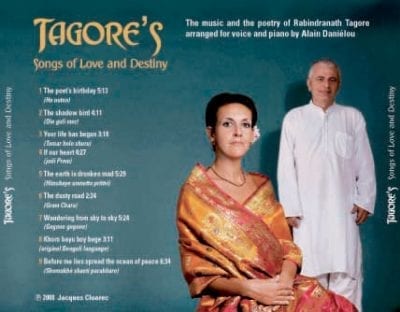
Tagore, with a Roman touch :
Dipanita Nath
Thursday , August 21, 2008 at 12:32:46
Two Italian performers bring alive the poet’s music. An Italian woman singing English versions of Bengali songscomposed by none other than the legendary Rabindranath Tagore. Add to this a predominantly Bengali audience and you begin to understand why the Italian vocalist, Francesca Cassio, felt she was walking on a razor’s edge.
Cassio, 38, and pianist Ugo Bonessi, 47, presented their renditions at the India International Centre on Tuesday, and as the applause cut into the last strains, both felt that they had just passed a really tough examination. “Tagore would have been very pleased today as he always wanted to spread his music in the west. In fact, he had urged French scholar Alain Daniélou to transcribe his songs for the western voice and piano,” said Cassio. She and Bonessi (picture left) are the first to have performed Rabindrasangeet according to the Daniélou notations.
Daniélou transcribed 18 songs, including the national anthem, into French and English, ensuring that the translated words were true to both Tagore’s meaning and melodies. “I feel as if I’ve just completed a project that Tagore and Daniélou started in 1932,” she added.
For a foreigner it is anything but easy to play Tagore, as Bonessi found out. “Unlike western classical notations, Tagore’s songs use ragas with its complex microtonal inflections that belong to the oral tradition of Indian gharanas. I could grasp these intricacies entirely due to my long interest in Indian classical music,” says Bonessi, who first heard the tabla during a Zakir Hussain show in London. “I was so awed that I began learning khayal and dhrupad. Bitten by the India bug, I visited the country in 1980 and then kept coming back,” he says.
Like him, Cassio had discovered the poet laureate early. “The west knows him only as a poet so it took me some time to realize he was also a composer,” she says. A national award-winning jazz singer from Rome, she became addicted to Indian classical music in the late 1990s. “I began learning Indian music at the Daniélou Foundation in Venice and followed it up by doing my Phd in Varanasi,” she says.
So, when the Daniélou Foundation started looking for the perfect voice to sing Tagore in English, their search threw up only one name — Cassio’s. “It was my grounding in Indian and western music that helped,” she says. It took her and Bonessi of them 18 months to learn 10 songs, all of which are part of a CD called Tagore’s Songs of Love and Destiny.
Their work is far from over. After a show in Kolkata, where Cassio’s guru Girija Devi will be present, the duo will visit Shantiniketan to complete learning the remaining eight songs. “And then, maybe, I can sleep in peace,” smiles Cassio.
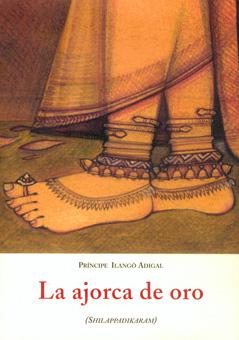 Editorial: J. J. Olañeta e Indica Books ISBN: 9788497164160
Editorial: J. J. Olañeta e Indica Books ISBN: 9788497164160
Fecha de Edición:06/2007
Traducido por :De la versión inglesa de Alain Danielou por Jesús
Aguado
Tiempo de Expédition: Hast 5 Días Tamaño: 150 X 210 mm.
Páginas: 170
Shilappadikaram (the Ankle Bracelet)
One of the great classics of Indian culture is the Shilappadikaram, or Lay of the Ankle Bracelet, a verse romance in the ancient Tamil language which is attributed to Ilangô Adigal, a Jain prince of the Third Century A.D.
This is a tale of wonders and misfortunes, of hapless mortals and capricious deities, of magic and heroism in a Bright but also cruel world in which he law of Karma rules : « actions committed in past lives must always bear fruit. » Thus the peerless Young Kôvalan will leave his loyal wife Kannaki for the courtesan Mâdhavi, and though he returns to her, still meet his death because of her ill-omened ankle bracelet ( Books I & II). Book III celebrates the exploits of Ilangô’s Brother, King Shenguttuvan, who conquers the Kings of the North to secure a great stone from the Himalayas for his temple to Kannaki, now apotheosized as
the Goddess of Faithfulness.
The Shilappadikaram has been called a, epic and even a novel, but it is also a book of general education. The ancient bards had to be teachers as well as poets, and Ilangô packed his story with information : history merging into myth., religious rites, caste customs, military lore, descriptions of city or country life ; he will pause in his tale to catalogue the rules and types of music and dance, while for Cantos are little anthologies of the poetry of the period ( seashore and mountain songs, hunters’ and milkmaids’ songs). Thus the Shilappadikaram gives us a vivid picture of early Indian life in all its aspects.
We are indebted to Alain Daniélou, author of the Bollingen Series Hindu Polytheism and studies of Asian music, for a new translation that is both scholarly and extremely readable.
Manimekhalaï :
The Manimekhalaï is one of the great classics of Indian culture. A second-century Tamil verse epic, it is a sequel to the Shilappadikaram, which was also masterfully translated into prose by the acclaimed musician and scholar of Hinduism, Alain Daniélou.
Rich with details of the period’s arts, customs and religions, the Manimekhalaï provides an extraordinary picture of an age that suddenly comes back to life. It is the story of a beautiful young dancer who decides to forego her looming career as a courtesan in order to dedicate her life (with the aid of gods, demigods, and a magic bowl called the Cow of Abundance) to charity and to attaining the “bright light of knowledge.”
Thèse
School of Music “Arrigo Bedroll” –Vicenza, Italy
“Ca’Foscari” University, Venice
Degree Thesis – Academic Level
Gianpaolo Peres
Alain Daniélou and the Dhrupad Revival
Supervisor: Prof. Francesca Cassio
Co-Supervisor: Prof: Roberto Perinu
Introduction
The roots of this thesis are firmly anchored in the course of Non-European Musical Traditions – Indian Studies Stream, at the University of Vicenza.
The idea was given me by Prof. Amelia Cuni, with whom I had been studying Dhrupad singing since 1991, following her seminars, and with private lessons, and now at the School of Music.
Especially as a result of her teaching, I now manage to glimpse the meaning of oral tradition, which is the basic structure and content of my research: the guru-shishya-parampara system.
There is a teacher and a disciple, listening and repeating, and daily practice.
It seems like something from another era, and yet it is an experience that is evolving: didactic, human, alive, of inestimable value.
It was through this inner/outer journey, that my need to examine the related historical and philosophic aspects brought me to Alain Daniélou, a great scholar whose centenary occurs this year.
He, too, speaks of disciple and teacher, and of India with its millennial tradition, its culture, history, where nothing seems to change and yet everything changes continuously, without ever stopping.
For the West, its presence is fundamental. Colonial empires have to acknowledge the independence of other peoples and accept their existence.
Daniélou took a basic step and became a Hindu, and his work, study and his life itself provide us with a feasible viewpoint on the Indian world, but from the inside, from the core.
He conveys and translates with knowledge and incredible open-mindedness a tradition that goes back to the dawn of time, but – as if by magic – seems to have left its traces and has come down to us.
On his return to Europe in the ’sixties, he found a soporific continent, unaware of the existence of other worlds and cultures. Through the major tasks he directed, he worked ceaselessly to develop perception and awareness, applying the parameters of his profound knowledge of Indian disciplines.
Thus his books, his translations and records, marketed under the aegis of Unesco, the institutes he set up for the study, classification and publication of music: concepts that are familiar to us today, though not then.
The first concert by Indian artists in the West was organized by Daniélou through his Institute for Comparative Music Studies in Berlin, as well as one of the records belonging to the Unesco collection, of which more below, both of exceptional importance.
In twenty-first-century recording studio terms, we could say that Daniélou produced the Dagar brothers.
We have thus identified two poles: East and West, Daniélou and the Dagar lineage, which has its roots in the purest and most ancient musical tradition of a devotional and courtly India of the Dhrupad style.
The story of this family and its direct descendants, Moinuddin and Aminuddin Khan Dagar, shows us through the Dhrupad much of the history and changes of northern India. Through this music, we can follow the history of a continent permeated by an incredible cultural syncretism.
Alain Daniélou was the man responsible for bringing us all this, not only the preconceptions, so that our ears can hear and our eyes see.
He made the Indians aware of their own history and opened new spaces in European awareness. He taught people to perceive, through study and by demonstrating the parameters, that there is not only one kind of great music, but many kinds: not just one great civilization, but many.
This research has been possible thanks to the guidance and direction of Prof. Francesca Cassio, who also made possible two splendid interviews/conversations; to the director of the Daniela Centre, Jacques Cloarec, and to Dr Ritwik Sanyal, disciple/teacher and friend of the Dagar family; and to the support of Dr. Roberto Perinu who helped me unravel the web of Maya.
Beside the research material supplied by my teachers and by Werner Durand, I have also been able to consult the magnificent heritage of the Italy and Orient Library and Archive of the Comparative Music Institute at the Cini Foundation on the Island of S. Giorgio in Venice, with their inexhaustible resources.
The day on which I consciously accepted this research, on the photocopier at the School of Music, I found a printed sheet that someone had left there, which contained a paragraph highlighted in red:
“As Daniélou explains, “the circle is an illusion; cosmic reality is actually always made up of spirals Nothing ever returns to its point of departure. The circle, however, does provide us with a simplified image.” (A. Daniélou, While the Gods Play, Inner Traditions, Rochester Vermont, 1987 – la fantaisie des dieux et l’aventure humaine, d’après latradition shivaïte, Editions du Rocher, Paris-Monaco, 1985, page 17)”
To me, it seemed a premonition and, since it had to do with my work, that’s how I began this research…
